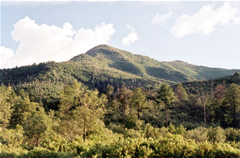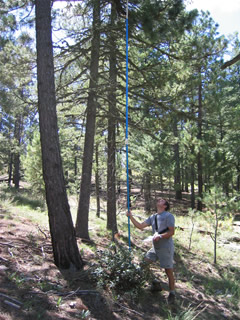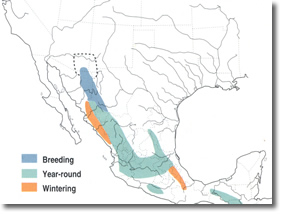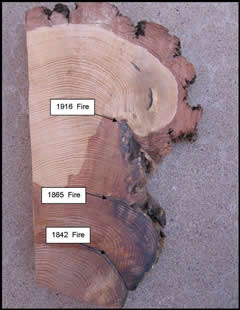Buff-breasted Flycatchers; distribution, population trends, and effects of fire
The distribution of buff-breasted flycatchers (Empidonax fulvifrons) in the U.S. once extended from the Mexico border north to Prescott, Arizona, east to west-central New Mexico, and south along the Continental Divide. However, the distribution of buff-breasted flycatchers decreased markedly in Arizona between the late 1800s and 1970. Distribution in the U.S. has been reduced by 91% from 98,630 sq. km to only 8,471 sq. km and 98% of the U.S. population is now restricted to 2 relatively small mountain ranges (Chiricahua and Huachuca) in southeastern Arizona (Conway and Kirkpatrick 2007). Indeed, the buff-breasted flycatcher has one of the most restricted breeding distributions of any bird in the U.S. In addition to their greatly reduced distribution, buff-breasted flycatchers have experienced a substantial population decline in recent years (Conway and Kirkpatrick 2007).
Consequently, buff-breasted flycatchers are considered a “very high priority” among species most in need of conservation action or study in the U.S. Buff-breasted flycatchers in the U.S. are susceptible to extirpation because of their limited distribution, small population size, and continuing population decline. Preventing extirpation of buff-breasted flycatchers from the U.S. requires population increases and/or recolonization of their historical range. However, expansion of buff-breasted flycatcher populations may require active management efforts to restore sub-optimal habitat. Several authors have suggested that long-term fire suppression may have caused population declines by reducing the amount of optimal foraging habitat available to buff-breasted flycatchers.
During a recent study, we found correlative data suggesting that buff-breasted flycatchers prefer burned forests in southeastern Arizona, particularly those areas affected by severe fires (Conway and Kirkpatrick 2007). We took advantage of the extreme wildfire seasons of 2002, 2003, and 2004 in southeastern Arizona to further examine the effect of wildfires of varying severities on the distribution and relative abundance of buff-breasted flycatchers. We conducted post-burn surveys in 2004 and 2005 along survey routes established in 2000 so that we could compare relative abundance of buff-breasted flycatchers before and after the recent wildfires. We also collected samples from fire-scarred trees in forests with and without buff-breasted flycatchers to examine the role of fire history in influencing the current distribution of buff-breasted flycatchers in southeastern Arizona.
We found that recent wildfires appear to have had little immediate effect on the distribution and relative abundance of buff-breasted flycatchers in southeastern Arizona. However, we found evidence (based on fire-scar records) suggesting that buff-breasted flycatchers prefer forests that have been burned more frequently within the last 30 years compared to adjacent forests that have burned less frequently (Kirkpatrick et al. 2006). In addition, we found that the number of buff-breasted flycatchers has increased from 2 to 5 birds (including a mated pair) in the Rincon Mountains since 2000. These detections represent the first records of buff-breasted flycatchers in this mountain range since 1911, suggesting that this rare species has re-colonized a portion of its historical breeding range (Kirkpatrick et al. 2007). We suspect that the recent arrival of buff-breasted flycatchers into the Rincon Mountains is due to a recent increase in the frequency of fires within this mountain range.
Our results add to a growing body of correlative and anecdotal evidence supporting the hypothesis that fire suppression has been responsible, in part, for the range contraction and population declines of buff-breasted flycatchers in the southwestern U.S. during the 20th century. Furthermore, our results indicate that buff-breasted flycatchers may ultimately benefit from recent wildfires in southeastern Arizona (and elsewhere in the State) as forest succession transforms recently burned areas into potential buff-breasted flycatcher habitat. Additional research is needed to confirm or refute the hypothesis that buff-breasted flycatchers prefer burned forests and continued monitoring of buff-breasted flycatcher populations is warranted given the small population size and restricted geographic range of this rare species in the U.S.
This research was funded by the USDA/USDI Joint Fire Sciences Program (#03-3-3-26), the Arizona Game and Fish Department Heritage Fund (#I99028 and #I04011), and the U.S. Fish and Wildlife Service’s Neotropical Migratory Bird Conservation Act Grant Program (#AZ-N31). We thank the technicians and volunteers who have made this project possible through their dedicated field work.
.jpg)



.jpg)




Publications:
- Conway, C. J., and C. Kirkpatrick. 2007. Effect of forest fire suppression on Buff-breasted Flycatchers. Journal of Wildlife Management 71:445-457.
- Kirkpatrick, C., C. J. Conway, and D. LaRoche. 2007. Range expansion of the Buff-breasted Flycatcher (Empidonax fulvifrons) into the Rincon Mountains, Arizona. Southwestern Naturalist 52:149-152.
Presentations:
- Kirkpatrick, C ., and C. J. Conway. 2007. Changes in the breeding distribution of Buff-breasted Flycatchers in the southwestern United States: the role of fire suppression. Arizona Field Ornithologists first annual membership meeting, Gilbert, Arizona.
- Conway, C. J., and C. Kirkpatrick. 2007. "Effects of fire suppression, fire severity, and fire frequency on Buff-breasted Flycatchers and other montane forest birds in the Sky Island Mountain Ranges of southern Arizona". American Ornithologists' Union annual meeting, Laramie, Wyoming. Symposium presentation.
- Kirkpatrick, C., and D. LaRoche. 2005. Potential range expansion of the Buff-breasted Flycatcher (Empidonax fulvifrons) into the Rincon Mountains, Arizona. Presented to Saguaro National Park volunteers.
- LaRoche, D., C. Kirkpatrick, and C. J. Conway. 2005. "Proposed evaluation of methods for measuring burn severity in forests during avian surveys". 4th USGS Wildland Fire Sciences Workshop, Tucson, Arizona. Poster presentation.